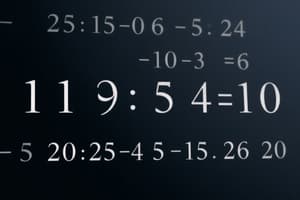Podcast
Questions and Answers
How did the discovery of the electron influence the model of the atom?
How did the discovery of the electron influence the model of the atom?
It led to the creation of the plum pudding model, which described atoms as a sphere of positive charge with negative electrons inside.
Outline the expected outcome of the alpha particle scattering experiment based on the plum pudding model.
Outline the expected outcome of the alpha particle scattering experiment based on the plum pudding model.
Alpha particles were expected to pass straight through or be only slightly deflected due to the diffuse positive charge of the 'plum pudding' atom.
Explain how the results of the alpha particle scattering experiment contradicted the plum pudding model.
Explain how the results of the alpha particle scattering experiment contradicted the plum pudding model.
A small number of alpha particles were deflected at large angles, and some bounced back, indicating a concentrated positive charge rather than a diffuse one.
How did the alpha particle scattering experiment lead to the development of the nuclear model of the atom?
How did the alpha particle scattering experiment lead to the development of the nuclear model of the atom?
Describe the key features of the plum pudding model of the atom.
Describe the key features of the plum pudding model of the atom.
What evidence led to the rejection of the plum pudding model and the acceptance of a new atomic model?
What evidence led to the rejection of the plum pudding model and the acceptance of a new atomic model?
What are the main differences between the plum pudding model and the nuclear model of the atom?
What are the main differences between the plum pudding model and the nuclear model of the atom?
In the alpha particle scattering experiment, what accounted for the fact that most of the alpha particles passed straight through the gold foil?
In the alpha particle scattering experiment, what accounted for the fact that most of the alpha particles passed straight through the gold foil?
What is the significance of the few alpha particles that were deflected at large angles in Rutherford's experiment?
What is the significance of the few alpha particles that were deflected at large angles in Rutherford's experiment?
Explain why the concept of the atom has changed over time.
Explain why the concept of the atom has changed over time.
Describe the role of Ernest Rutherford in the development of the nuclear model.
Describe the role of Ernest Rutherford in the development of the nuclear model.
Thomson's plum pudding model was an improvement over Dalton's model. Explain why.
Thomson's plum pudding model was an improvement over Dalton's model. Explain why.
What was the role of the gold foil in the alpha particle scattering experiment, and why was gold used?
What was the role of the gold foil in the alpha particle scattering experiment, and why was gold used?
In what way did the Greeks contribute to the theory of the atom?
In what way did the Greeks contribute to the theory of the atom?
Explain how the charge of the nucleus was determined through the alpha particle scattering experiment.
Explain how the charge of the nucleus was determined through the alpha particle scattering experiment.
How does the scattering angle of an alpha particle relate to its proximity to the nucleus?
How does the scattering angle of an alpha particle relate to its proximity to the nucleus?
Why was the large proportion of undeflected alpha particles in Rutherford's experiment significant?
Why was the large proportion of undeflected alpha particles in Rutherford's experiment significant?
Explain the role of detectors in the alpha particle scattering experiment.
Explain the role of detectors in the alpha particle scattering experiment.
How did the alpha particle scattering experiment influence the development of new scientific models?
How did the alpha particle scattering experiment influence the development of new scientific models?
Outline the significance of Dalton's atomic theory in the 19th century.
Outline the significance of Dalton's atomic theory in the 19th century.
Flashcards
Plum Pudding Model
Plum Pudding Model
Early model of the atom; a sphere of positive charge with negative electrons embedded inside.
Alpha Particle Scattering Experiment
Alpha Particle Scattering Experiment
An experiment where alpha particles were directed at a thin gold foil to probe atomic structure.
Nucleus
Nucleus
The dense, positively charged center of an atom.
Results of Alpha Particle Scattering
Results of Alpha Particle Scattering
Signup and view all the flashcards
Conclusions from Scattering Experiment
Conclusions from Scattering Experiment
Signup and view all the flashcards
Dalton's Atomic Theory
Dalton's Atomic Theory
Signup and view all the flashcards
Thomson's Atomic Model
Thomson's Atomic Model
Signup and view all the flashcards
Study Notes
Complex Numbers Definition
- Complex numbers take the form z = a + bi.
- a and b are real numbers
- i is the imaginary unit where i = √-1.
Components
- The real part of zis a, denoted as Re(z).
- The imaginary part of z is b, denoted as Im(z).
Examples
- For z = 3 + 2i, Re(z) = 3 and Im(z) = 2.
- For z = -1 - i, Re(z) = -1 and Im(z) = -1.
- For z = 4i, Re(z) = 0 and Im(z) = 4.
- For z = 5, Re(z) = 5 and Im(z) = 0.
Complex Plane
- A complex number z = a + bi is a point (a, b) on the complex plane.
- The x-axis represents the real axis.
- The y-axis represents the imaginary axis.
Complex Plane Example
- 3 + 2i is represented by (3, 2)
- -1 - i is represented by (-1, -1)
- 4i is represented by (0, 4)
- 5 is represented by (5, 0).
Modulus
- The modulus of z = a + bi is the distance from the origin to the point (a, b) on the complex plane.
- |z| = √(a² + b²)
Modulus Examples
- If z = 3 + 4i, then |z| = √(3² + 4²) = 5.
- If z = -5 - 12i, then |z| = √((-5)² + (-12)²) = 13.
- If z = 8i, then |z| = √(0² + 8²) = 8.
- If z = -6, then |z| = √((-6)² + 0²) = 6.
Complex Conjugate
- The complex conjugate of z = a + bi is denoted as z = a - bi.
- The conjugate is found by changing the sign of the imaginary part.
Complex Conjugate Examples
- If z = 2 + 3i, then the conjugate is 2 - 3i.
- If z = -1 - 5i, then the conjugate is -1 + 5i.
- If z = 7i, then the conjugate is -7i.
- If z = 4, then the conjugate is 4.
Operations with Complex Numbers
- Given z₁ = a + bi and z₂ = c + di:
Addition
- z₁ + z₂ = (a + c) + (b + d)i
Subtraction
- z₁ - z₂ = (a - c) + (b - d)i
Multiplication
- z₁ ⋅ z₂ = (ac - bd) + (ad + bc)i
Division
- z₁ / z₂ = ((ac + bd) / (c² + d²)) + ((bc - ad) / (c² + d²))i
Operation Examples
- Given z₁ = 3 + 2i and z₂ = 1 - i:
Addition
- z₁ + z₂ = (3 + 1) + (2 - 1)i = 4 + i
Subtraction
- z₁ - z₂ = (3 - 1) + (2 - (-1))i = 2 + 3i
Multiplication
- z₁ ⋅ z₂ = (3(1) - 2(-1)) + (3(-1) + 2(1))i = 5 - i
Division
- z₁ / z₂ = ((3 + 2i) / (1 - i)) = (1/2) + (5/2)i
Studying That Suits You
Use AI to generate personalized quizzes and flashcards to suit your learning preferences.



